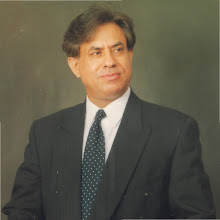Future trends show that the world poverty is decreasing and we are nearing the era when the poor of today will live the standard of the average rich of today. Contrary to this trend, in Pakistan poverty levels are going further up. Although many Pakistanis have greatly improved their standard of living since 1947, yet over 30 percent of them—around 50 million people—still live below the poverty line. The gap between the rich and poor has widened with some gaining financial comfort while others are finding it impossible to permanently escape from destitution.
Poverty is hunger. Poverty is lack of shelter. Poverty is being sick and not being able to see a doctor. Poverty is not being able to go to school and not knowing how to read. Poverty is fearing the future, living one day at a time. Poverty is losing a child to illness brought about by unclean water. Poverty is powerlessness, lack of representation, and freedom.
Poverty has many faces, changing from place to place and across time, and has been described in many ways. Most often, poverty is a situation people want to escape. So poverty is a call to action—for the poor and the wealthy alike—a call to change the world so that many more may have enough to eat, adequate shelter, access to education and health, protection from violence, and a voice in what happens in their lives.
For many, lack of access to income-generating activities, coupled with lack of basic services in education and health, is the determining factors behind acute poverty. In Pakistan, lack of access to credit, training in income-generating activities, basic social services, and infrastructure are critical factors behind the persistence of substantial poverty, especially in underserved rural and urban areas. Poverty levels also differ depending on where people live. The metropolitan poverty rate differs greatly between suburbs and the central city.
At the Millennium Summit in 2002, major development organizations looked at development goals, which had been agreed at international conferences and world summits during the 1990s, and distilled them into eight goals with eradication of extreme poverty and hunger at top. The Goals were formed in response to what was seen as uneven development progress, where globalization benefits millions, but poverty and suffering still exist.
This is scarcely surprising considering that those who live below the poverty line and that any supplementary income from working children becomes unavoidable for their families to make ends meet. We have to understand as why children go to work. If parents don't send their children to work I am sure factories will not be able to consume them. No mother likes her child to go for work. It is financial crisis, which forces. Our understanding should be little more practical as no parents want their children work at the age when children are to study and play.
The stress on a gradual approach towards eliminating child labor is the correct one. At the same time, poverty alleviation efforts must be stepped up, so that the loss of an earning member of the family is not felt, so actually and over an indefinite period of time.
Poverty is no longer just a matter of calories or of pricing a consumption bundle. It has to do with the poor defining and achieving their well being themselves and living a life in a participative society where the State is an enabling rather than a hindering institution. It is not that income or consumption level is unimportant. It remains at the core of any definition of poverty. But we must view it as an input as much as an outcome. It is an input which contributes towards well being. But just as important are public goods – health care, clean water, literacy, and healthy environment.
Pakistan's rural sector accounts for more than 70 percent of employment, and roughly two thirds of rural employment is in agriculture. Less than a third of rural households get loans, only 10 percent of which are from institutional sources. Pakistan's credit institutions are not helping the country accelerate agricultural growth and reduce poverty.
To improve performance in the rural economy and efficiency in financial institutions, rural credit markets must be liberalized.
Produce and price controls must be replaced by prudent regulation and supervision, combined with policies to stabilize the economy. Commercial banks must operate in a competitive environment. They must be allowed to set interest rates for rural lending that cover their transaction costs. Credit must be made available to support productivity growth for agricultural smallholders and small producers of the rural non farm sector, where Pakistan's growth potential lies. Credit must be made available to women and to the rural poor for consumption smoothing and for sustainable income generating activities.
Policy should be directed at developing a market based financial system for rural finance, but because of market failures to support disadvantaged groups, a special priority program may be needed to get credit to women, smallholders, and the rural non-farm sector.
Subsidizing interest rates is not the way to help marginal borrowers. Instead, they can be helped through fixed cost subsidies and self-selected targeting. NGOs should be encouraged to help, keeping in mind such success stories as the Grameen Bank in Bangladesh and Badan Kredit Kecaratan (BKK) in Indonesia.
Pakistan needs to make the policy choices to help it translate economic gains into real poverty alleviation for its citizens. It needs social protection, human development, and a well-coordinated rural strategy. Issues of governance are at the heart of many of the difficulties encountered in mitigating poverty and broadening access to social services for the poor. (www.asifjmir.com)
A Distinct Candle is Extinguished!
-
“I am announcing, with a heavy heart, the sudden demise of my beloved
father, Asif Javed Mir, due to heart failure on 18th December,2013. I
request to ever...
11 years ago





No comments:
Post a Comment